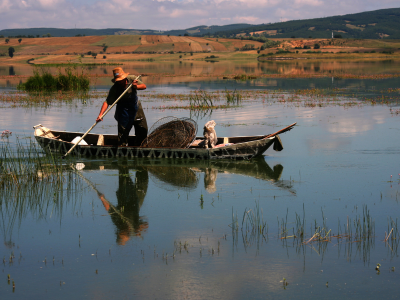
Europe and Central Asia Regional Overview of Food Security and Nutrition 2024
Managing water sustainably for improved food security and nutrition
This report provides the latest updates on hunger, food insecurity and malnutrition in Europe and Central Asia, including the cost and affordability of healthy diets. It also explores the central theme of water security, highlighting its critical connections to agriculture, food security and nutrition. While the region has made progress in reducing hunger and food insecurity (SDG Target 2.1), challenges remain in eliminating all forms of malnutrition (SDG Target 2.2).
Collections
- Country gender assessment series
- Digital agriculture
- Disaster risk reduction and management publication series
- Empowering smallholders and family farms series
- Transboundary animal diseases - Leaflets
Multimedia resources
Publications

University curriculum assessment on the learning outcomes related to antimicrobial resistance at the Department of Veterinary Medicine in the Faculty of Science and Technology at the Jalal-Abad State University named after B. Osmonov
12/2025
The Strengthening Veterinary Education on Antimicrobial Resistance series compiles assessment reports of veterinary education institutions, detailing strengths and areas for improvement in the institutions’ curricula, and recommendations to enhance their education on antimicrobial resistance (AMR) learning outcomes (LOs). Data was gathered through assessments performed using the Ohio State University's "Evaluation Tool to Assess AMR Learning Outcomes".

Europe and Central Asia Gender Newsletter, December 2025 – Issue #20
12/2025
This issue of the Europe and Central Asia Gender Newsletter brings together policy insights and field stories as countries across the region step up preparations for the International Year of the Woman Farmer 2026.

Improving poultry health and productivity
12/2025
This volume is part of a broader series that also addresses other major production systems and livestock species, including dairy cattle, beef cattle, and small ruminants. The content and design of these brochures were developed and tested in Armenia, Kazakhstan, Kyrgyzstan, and Tajikistan. Demonstration farms, pilot trainings, and farm visits were used to assess and refine the materials based on local realities.

National gender profile of agriculture and rural livelihoods – Uzbekistan
12/2025
The Country Gender Assessment shows persistent gender inequalities in Uzbekistan’s agrifood systems. Rural women face limited access to land, services and decent work, heavy unpaid care burdens, and high levels of exclusion among young women. The assessment provides evidence to address these structural barriers and advance gender equality.

Improving dairy cattle health and productivity
12/2025
This highly visual set of training materials focuses on core farm-level practices known to impact animal health and production outcomes, such as colostrum management, calfhousing, nutrition, milking hygiene, and biosecurity. Each topic can be covered in a short, focused session (30–90 minutes), ideally combining discussion, visual aids, and on-farm demonstration.

Irrigation service delivery and management transfer in Central Asia, Türkiye, and Azerbaijan
12/2025
This FAO volume examines three decades of irrigation management reform in the FAO Subregional Office for Central Asia region, tracing the transition from the state-led “hydraulic mission” to farmer-based irrigation management transfer (IMT). While IMT was widely promoted as a means to improve efficiency, sustainability, and equity through water users' associations (WUAs), outcomes have been highly uneven, with successes, partial rollbacks, and even reversals.

From stockpiles to sustainability: Seven years of transforming pesticide management in Central Asia and Türkiye
12/2025
This final publication, entitled From stockpiles to sustainability: Seven years of transforming pesticide management in Central Asia and Türkiye, presents the comprehensive results of the GEF-funded, FAO-implemented project “Lifecycle Management of Pesticides and Disposal of POPs Pesticides in Central Asian Countries and Türkiye.”The report synthesizes the project's major accomplishments, critical insights, and strategic guidance gained over seven years of regional collaboration.

Ukraine: Humanitarian response update, 1 December 2025
12/2025
Through its Emergency and Early Recovery Response Plan for 2025, the Food and Agriculture Organization of the United Nations (FAO) requires a total of USD 150 million to assist 550 000 people in rural areas, including small-scale farmers, by providing agricultural production inputs to ensure they can rely on their own food production.

National e-agriculture strategy - Digital transformation in agriculture 4.0 2021–2025
11/2025
The main purpose of this e-agriculture strategy publication is to support agriculture and rural development by increasing access to valuable information that will help people whose livelihoods depend on agriculture make the best possible decisions and use available resources in the most efficient and sustainable way. This publication is based on evaluations made by FAO regarding e-agriculture and the e-learning content handled within the scope of the strategy.

The State of Mediterranean and Black Sea Fisheries 2025
11/2025
This 2025 edition of the GFCM flagship publication The State of Mediterranean and Black Sea Fisheries presents the most comprehensive and up-to-date review of fisheries and aquaculture status and trends in the Mediterranean and Black Sea region. The sixth installment of this report is the most ambitious to date and comes as a result of an unprecedented collaborative effort across the region.

Revitalizing the Albanian dairy sector in the context of food, energy and financial crises
11/2025
This report provides an in-depth analysis of Albania’s dairy sector, a critical component of the country’s agricultural economy. Despite recent improvements in farm productivity, the sector faces significant challenges including fragmented landownership, declining cattle numbers, and mounting production costs.

FAO Türkiye Newsletter, November 2025 – Issue #22
11/2025
The 22nd edition of the FAO-Türkiye Newsletter showcases key milestones in building resilient agrifood systems and safeguarding biodiversity. Featured stories include the Hepyerinden initiative connecting rural women’s cooperatives to national e-commerce markets, the Seeds of Resilience project supporting recovery in earthquake-affected regions, and regional efforts to restore forests and protect flamingos.

Antimicrobial use practices in the livestock sector in Ukraine
11/2025
The Understanding Antimicrobial Use in Food and Agriculture series is a compilation of country reports, each describing antimicrobial use (AMU) practices and awareness of antimicrobial resistance (AMR) in the livestock sector. The data presented in these reports was obtained through knowledge-attitudes-practices (KAP) field surveys conducted with farmers of priority livestock production systems, field veterinarians, veterinary pharmacies, and feed mills.

Antimicrobial use practices in the livestock sector in Georgia
11/2025
The Understanding Antimicrobial Use in Food and Agriculture series is a compilation of country reports, each describing antimicrobial use (AMU) practices and awareness of antimicrobial resistance (AMR) in the livestock sector. The data presented in these reports was obtained through knowledge-attitudes-practices (KAP) field surveys conducted with farmers of priority livestock production systems, field veterinarians, veterinary pharmacies, and feed mills.

Small ruminant value chains in the Republic of Moldova
11/2025
This report presents a comprehensive analysis of the small ruminant value chains in the Republic of Moldova, focusing on opportunities, challenges, and potential for growth. Small ruminant farming, primarily conducted by family farms, plays a vital role in rural livelihoods, contributing significantly to household income through meat, milk, and cheese production.
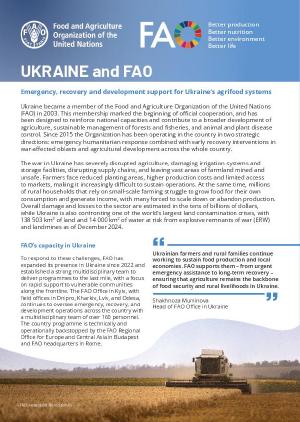
Emergency, recovery and development support for Ukraine’s agrifood systems
11/2025
The publication “Ukraine and FAO” provides an overview of the Food and Agriculture Organization of the United Nations (FAO) activities and achievements in Ukraine since the escalation of the war in 2022. It outlines how FAO, in partnership with the Government of Ukraine and international donors, supports farmers, rural households and institutions to safeguard food security, sustain production and rebuild livelihoods.
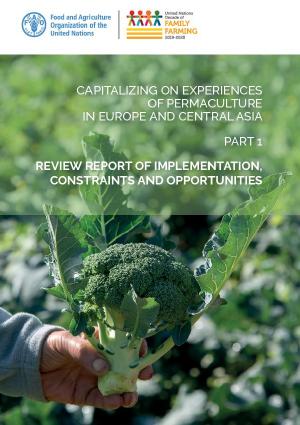
Capitalizing on experiences of permaculture in Europe and Central Asia
10/2025
This publication, "Capitalizing on experiences on permaculture in Europe and Central Asia: Review report of implementation, constraints, and opportunities", is the first part of a two part publication. The review report provides an in-depth look at the practice of permaculture in Europe and Central Asia, exploring its ethics and principles, as well as its benefits and application.
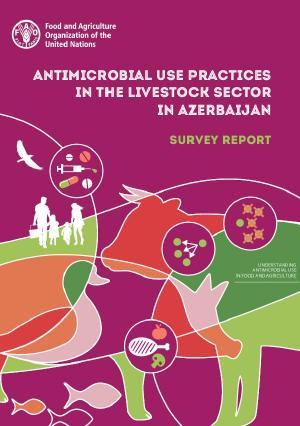
Antimicrobial use practices in the livestock sector in Azerbaijan
11/2025
The Understanding Antimicrobial Use in Food and Agriculture series is a compilation of country reports, each describing antimicrobial use (AMU) practices and awareness of antimicrobial resistance (AMR) in the livestock sector. The data presented in these reports was obtained through knowledge-attitudes-practices (KAP) field surveys conducted with farmers of priority livestock production systems, field veterinarians, veterinary pharmacies, and feed mills.
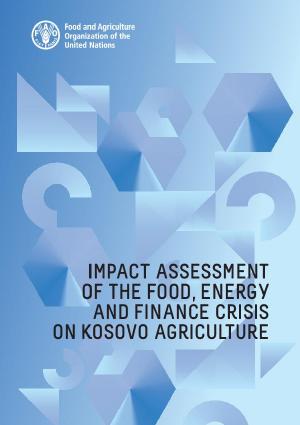
Impact assessment of the food, energy and finance crisis on Kosovo agriculture
11/2025
This report explores how the global food, energy, and financial crisis has affected Kosovo's agricultural sector, examines changes in production factors, input use, yields, profitability, food security, migration, and policy perceptions. Using surveys, analyses, and interviews, it offers insights and recommendations to strengthen resilience and sustainability.
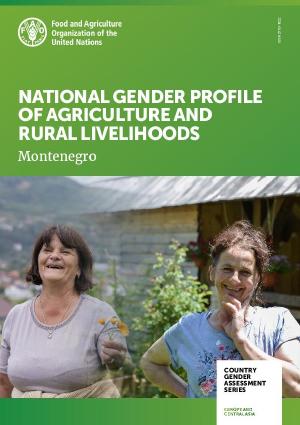
National gender profile of agriculture and rural livelihoods – Montenegro
10/2025
FAO’s first Country Gender Assessment for Montenegro analyses the situation of women and men in agriculture and rural development, identifying key gender gaps and opportunities. It provides a basis for integrating gender perspectives into FAO programmes and national policies for more inclusive, gender-responsive rural development.
